|
|
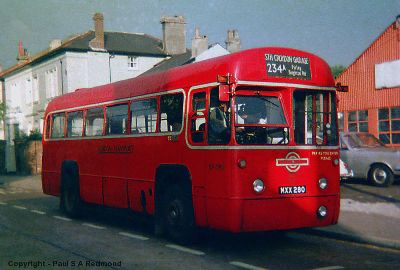 Red RF routes Red RF routes
Route 234A
Page last updated 27 July
2019
A very long-lived RF route, converted from the last scheduled
LTLs at the start of 1953 with new buses.
RF392, on the stand at
Wallington Belmont Road in the mid-70s, is about
to return to Croydon garage.
Photo
© Paul Redmond
Dates of RF
operation
12 Jan 53 to 29 Jan 77
Converted to OMO 7 Aug 66
(total 24 years 1 month, of which 13 years 7
months crew operation)
Destinations
PURLEY Old Lodge Lane and HACKBRIDGE Elm
Road (daily to 6 Aug 66, daily except Mon-Fri peaks 7 Aug 66
to 16 Feb 68 and from 20 Apr 70, Sat-Sun 17 Feb 68 to 19 Apr
70)
PURLEY Old Lodge Lane and WALLINGTON STATION
(Mon-Fri peaks from 7 Aug 66, also Mon-Fri off-peak 17
Feb 68 to 19 Apr 70)
RF Garages
TC Croydon
Reason for single-deck operation
There were low bridges at both ends of the route in the early
days, at Wallington Station and on Old Lodge Lane by Reedham
Station. Whilst the road was lowered beneath the railway to
Wallington, the 13'6" bridge over Old Lodge Lane remains.
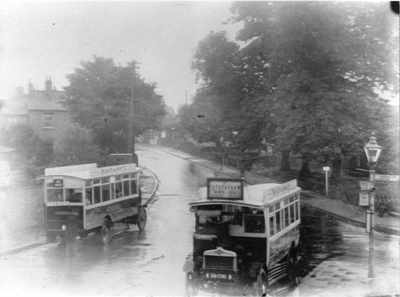
Route history
Southbound and northbound
S-types pass on route 87 at Hackbridge Triangle in about
1925. S780 on the left heads down London Road bound for
Purley via Wallington, whilst S892 leaves from the LGOC bus stop
for Streatham. This location became the northern terminus for
the 234A, with Elm Road behind and to the right of the
photographer. The area is somewhat changed today
(view
looking north, photo © Peter Larkham).
Photo Sutton Local
Studies & Archives Centre collection
As Purley developed, early in the 20th century, the central
part of this route had a slow introduction to bus services.
The first horse bus service up Foxley Lane ceasing in 1908 after
three years as 'it was not supported by the wealthy Purley
residents who have their own carriages', but was restarted with
support from the developer of Woodcote Grove, between there and
Wallington. From 1914, the route between Purley and Woodcote
Park Golf Club was being operated by a motor bus. The
route operated during at least part of the first world war, but may
not have been reintroduced thereafter. In 1921, there were
reports locally that the General were planning a route through the
area.
This came into being as the first service on
the north-south route between Streatham and Purley via Mitcham
and Wallington Green, route 87 commencing in September 1921.
Initially Merton garage (AL) provided B-type single-deckers, with
Streatham (AK) taking over in March 1922 and replacing Bs with Ss a
year later. The 87 was renumbered 234 in 1934, by which time Sutton (A) had taken
over the route and replaced the Ss with LT Scooters in 1931.
In 1937, the 234 was cut back to operate south from Carshalton
Park Lane, and a year later extended from Purley
Railway Hotel to Mitchley Avenue replacing part of the
203.
The 203 was another manifestation of
the development of Purley to the south and east, running in a
horseshoe-shape from Riddlesdown Mitchley Avenue in
the east (where the turning circle was just east
of Buttermere Gardens) to Old Lodge Lane to the
south-east. It commenced operation in September 1935 using
the only two Gilfords operated by the Central Area.
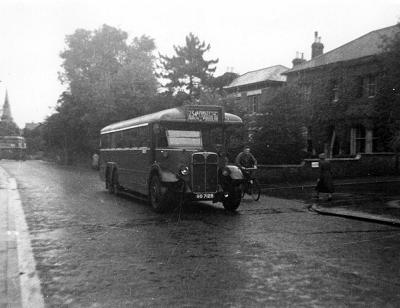 LT1090 runs south to Purley in the
early 50s, carrying one of the bodies rebuilt by Marshalls in 1949
and having had its petrol engine replaced by a diesel (from a
scrapped STL) in 1950. This is Manor Road, Wallington, at the
junction of Clifton Road. In the background, one of
Merton's utility Daimlers emerges from Parkgate Road on either
the 77 or 157. It will terminate by turning left into Clifton
Road, before the road reaches the low bridge at Wallington
Station.
Introduced on 3 Aug 38, the 234A replaced the
southern part of the 203 between Old Lodge Lane and Purley, then
ran along the 234 to Carshalton Park Lane, from Wallington
Station taking Parkgate Road, terminating just before the junction
with the High Street and returning via Acre Lane. At that
time, the Old Lodge Lane service terminated at Colescroft Hill, and
turned by reversing into Whitefield Avenue.
The route also used LTL Scooters from Sutton garage, initially
with a separate allocation but jointly with the 234 from
December 1939. Wartime constraints also led to a slight
shortening in October 1942, to Wallington Station, for the first
two months using a terminus in Grosvenor Road before
moving to the well-known Belmont Road stand over the
road. On 19 Apr 44, the joint 234 operation moved from Sutton
to Croydon garage (TC).
On 22 Feb 50, the 234 was double-decked (and therefore turned at
Beddington Gardens, south of the low bridge at Wallington Station),
whilst the 234A was extended to Hackbridge with its own
allocation of 5 LTLs. This section reintroduced a part of the
former route of the 234 to Streatham, which had been replaced
by the 115 in 1937.
New RFs arrived in January 1953, allowing the last scheduled
allocation of LTLs to retire (not quite the last in operation - see
the 208). The first RF was licensed
on 12 Jan 53, with the allocation complete four days later; the
last day of Scooter operation was Friday 16th when LTs 1024, 1090
and 1129 were delicensed. The RF allocation was unusual (but
not unique; Old Kent Road was in the same position for the
202) in containing no spare buses,
whereas there had been six LTLs to cover the five-bus
requirement. In Croydon's case, it seems likely that buses
were borrowed from Bromley to cover maintenance work undertaken
during the week. Newly overhauled post-war T767 was delivered
to Croydon on 11 April 1953 to provide a spare bus, until
a sixth RF was found in September 1954. This spare then
allowed Bromley to borrow an RF on
Saturday for the 227.
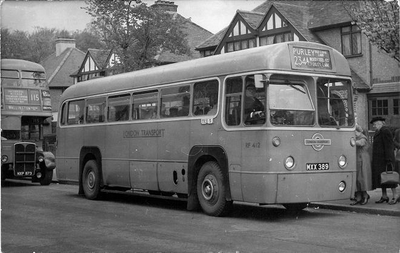
Seen during the mid-1950s, before it has been
fitted with trafficators, RF412 was one of the original
allocation. It is picking up in London Road, north of
Wallington Green, followed by RT4620 on the 115. The RT will
follow the RF all the way to Wallington Clifton Road, and
no doubt be careful to let the RF take all the passengers.
Photo Peter Osborn collection
The RFs went quietly about their business with no changes until
1 Jul 64, when the route was extended to the end of the housing in
Old Lodge Lane, some 500 yards further from the old terminus.
Apart from two minutes extra allowed in each direction, there was
no visible change to timetables, maps or blinds.
In January 1966, the route was temporarily withdrawn at
weekends, due to an overtime ban. An emergency service was
operated between Purley Fountain and Old Lodge Lane by
Capital Coaches until March.
For many years, short workings between Old Lodge Lane and Purley
Fountain had operated in addition to the through
route. In June 1966, to cover the withdrawal of the 234
between Purley and Wallington on Saturdays, these shorts were
extended on that day to cover the whole route, with an
overall frequency reduction. One extra RF on the
234A replaced one RM on the 234 - presumably this was
done in anticipation of imminent OMO conversion. The tangled
history of the 234 and 234A over the next few years are
described in the next paragraph, but at this point it is worth
noting that the total withdrawal of the 234 at weekends
followed on the last day of 1966, with the Purley to
Selsdon section (covering the northern part of the original 203)
being replaced on Sundays by the 57A, then in 1969 by
new OMO route 234B, using one
RF from Croydon spare from the 234A (and 233) on Sundays.
OMO conversion came in August 1966 and the frequency
increased with one more bus required on Mon to Sat.
However, the route was cut back at Mon to Fri peaks from Hackbridge
to Wallington; the RT-operated (on weekdays) 234 was extended in
exchange, presumably as this section was too busy for OMO operation
in the peaks. In February 1968, the whole Mon to Fri service
north of Wallington was replaced by the 234, which by now was Mon
to Fri only but still RT operated. The extension of the 234
survived, but the 234A was reinstated to Hackbridge Mon
to Fri off-peak in 1970.
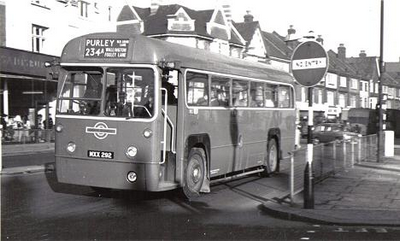
Crew-operated RF404 in
Purley, probably just after its overhaul in late 1964. The
route number holder over the door is now out of use.
Photo Peter Gomm
collection
It was not until 1977 that the RFs were ousted, on 30 January,
the same day as the 251, leaving
only four routes, at Hounslow and Kingston. They were
replaced by same-sized, but less comfortable, Bristol BLs, which in
1981 saw the route extended back over the pre-war territory of the
234 to Streatham, and were replaced by Leyland Nationals a year
later. The route was withdrawn in 1984, with the original 203
section to Old Lodge Lane then being covered by the
12A.
RF route in detail, with
timing points
PURLEY Old Lodge Lane, Old Lodge Lane, Brighton
Road, Purley
Fountain, Banstead Road, Foxley
Lane, Woodcote Smitham
Bottom Lane, Woodcote Road, Wallington Station, Manor
Road, Manor Road North, London Road, HACKBRIDGE CORNER
Elm Road (daily 12 Jan 53 to 7 Aug 66, Mon-Fri
off peak and weekends 8 Aug 66 to 16 Feb 68, weekends 17
Feb 68 to 19 Apr 70, Mon-Fri off peak and weekends 20 Apr
70 to 29 Jan 77)
PURLEY Old Lodge Lane, Old Lodge Lane, Brighton
Road, Purley
Fountain, Banstead Road, Foxley
Lane, Woodcote Smitham
Bottom Lane, Woodcote Road, WALLINGTON
STATION Belmont Road. (Mon-Fri peaks 8 Aug
66 to 16 Feb 68, Mon-Fri 17 Feb 68 to 19 Apr 70,
Mon-Fri peaks 20 Apr 70 to 29 Jan 77)
Terminal workings:
Hackbridge - arrive via Longfield Avenue to the Elm Road stand,
depart via Hackbridge Road to London Road.
Wallington - arrive via Clifton Road, Bridge Road, stand in
Belmont Road (also, earlier, in Bridge Road); depart direct to
Manor Road.
Old Lodge Lane (Colescroft Hill) - turn in layby at St Johns
Hill (now only a footpath at the Whitefield Avenue bus stop).
Old Lodge Lane (Canons Hill) - turning circle.
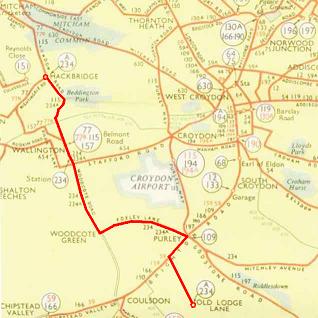
1955 bus map © London
Transport (1969 map of Croydon RF routes here)
Frequency
| Year |
Mon-Fri |
Sat
|
Sun |
|
1941
|
20-30 mins
|
20 mins
|
30 mins
|
|
1946
|
20-30 mins
|
20 mins
|
30 mins
|
|
1951
|
15-20 mins
|
15 mins
|
18-30 mins
|
|
1953
|
15-20 mins
|
15 mins
|
18-30 mins
|
|
1959
|
15-20 mins
|
20 mins
|
24-34 mins
|
|
1964
|
20 mins†
|
20 mins†
|
40 mins
|
|
1969
|
20 mins*
|
15 mins
|
40 mins
|
|
1971
|
24 mins*
|
20 mins
|
40-70 mins
|
|
1976
|
24 mins*
|
20 mins
|
40-70 mins
|
* Off-peak frequency; peak journeys Wallington and Purley
Old Lodge Lane every 10-11 mins
† Plus peak and Sat journeys Purley Fountain and
Purley Old Lodge Lane every 10 mins
From Purley Old Lodge Lane, the route took
about 29 minutes to reach Hackbridge. The November 1959
timetable is here and the July 1967
one here.
Faretable
The 1965 faretable is here.
RF allocation
New RFs delivered Jan 53: 408, 410, 412 + 299,
300 ex-trainers (total 5, no spares). RF485 was
transferred into Croydon in September 1954 to provide a spare.
PVR 1953 (Jan): Mon-Fri 5, Sat 5, Sun 3
PVR 1953 (May): Mon-Fri 5, Sat 5, Sun 4
PVR 1953 (Oct): Mon-Fri 5, Sat 5, Sun 3
PVR 1954 (May): Mon-Fri 5, Sat 5, Sun 4
PVR 1954 (Oct): Mon-Fri 5, Sat 5, Sun 3
PVR 1958 (Apr): Mon-Fri 5, Sat 4, Sun 3
PVR 1960 (Oct): Mon-Fri 5, Sat 4, Sun 2
PVR 1962 (May): Mon-Fri 5, Sat 5, Sun 2
PVR 1966 (Jul): Mon-Fri 5, Sat 6, Sun 2
PVR 1966 (Aug, OMO): Mon-Fri 6, Sat 7, Sun 2
PVR 1966 (Dec): Mon-Fri 6, Sat 5, Sun 2
PVR 1970 (Oct): Mon-Fri 6, Sat 4, Sun 2
Doug Ely has now retired
from London bus work, but recalls his time working from Croydon in
the 1970s:
'I transferred mid-1972 to South Croydon garage (TC) thus
being trained for RMLs and learning 59, 68,
130A/B, 190 and 197, quickly getting a place
on the 130/59 rota. Early in 1973, I trained as an
OMO driver and type-trained on the RF, finding a spot on the
'C' group rota and learning 166, 233,
234/A/B (see map here). Now, much to the
annoyance of the senior drivers on the 'C' group who with their
fareboxes did not have to handle money, TC's small allocation of
six duties on the 154 was placed on the same rota, this time I was
happy to allow my seniors to do my late shifts on the 'Cs' in exchange for their early shifts
on the 154.
Unfortunately the mid 1970s were not a happy period for the
DMS class, with often 50% of the pvr for the C1/C2 having no
serviceable bus resulting in us drivers sitting in the canteen for
hours on end, which personally I hated. Changing to the
233/234/A rota cured that and gave me the chance to
drive the RFs and later BLs, which were not as bad as people would
have you believe, particularly in the winter when the heaters were
much appreciated.
I always found the RF comfortable to drive as long as one
remembered to duck getting in and out of the cab; many a driver off
the DMS routes regretted working a rest day on the 'scooters' when
he cracked his skull the first time! One thing that stood out
was that the RF's performance did not seem to be affected by a
heavy load, but the steering was another matter. We had Dunlop
cross ply tyres at TC, which seemed out of all the major tyre
manufacturers to have the largest tread area on the road, thus
making the steering as heavy as could be. Towards the class’s
withdrawal we had a few temporary transfers in from either K or NB
which were fitted with radial tyres (Michelin I think) and were
very much easier to manoeuvre.
I started on 234 group in the summer months, quickly finding
that the RF could suffer from overheating (boiling) on hot days and
when caught in heavy traffic in the Purley area, probably due to
the underfloor engine and various water leaks. You could always
tell when the bus approached, by the position of the filler half
roundel flap, if it was down you were going to be broiled in the
cab. One bus, RF380, was particularly bad for this and was often
driven with the actual filler cap loosened, resulting in a very
steamy time at bus stops.
Of course the opposite was true in the winter months; saloon
heaters were often poor and the cab heater design meant that, at
the very time you needed the heat when stationary with the doors
open at a bus stop, the blower stopped as the engine was not
revving. Couple that with the thick rimmed steering wheel and
collection of coins for fares, which meant it was impossible to
keep your hands warm in gloves and you can see that we had quite a
tough time compared to DMS or RT/RM drivers.
Generally the 234 group was pleasant to work on without the
hassles of Central Croydon traffic and the various rough estates,
one thing however was a drag. Meal reliefs were, unless scheduled
to run a bus in or out of TC, allocated at Purley Crossroads itself
for about 45 minutes. Not enough time to get a bus to TC, have a
meal and get back to take on your next bus. With no cafes in the
local area to get a cuppa we had to sit on a bench at the bus stops
or wander the local shops and bring sarnies to eat during turn
around times at Old Lodge Lane or elsewhere. Needless to say the
Trade Union at TC was not a very strong one!
A few of the regular drivers lived on the Wallington end of the
route and, when schedules worked out, would nip home for their
break and return on the bus they were due to take on at Purley. As
a "new boy" I left one such driver behind because he had neglected
to warn me to look out for him and was not at the stop so did not
make the bus. Fortunately their were no passengers on board at
Purley, and he came back on the next bus and spent some time
chasing the clock to get back on time! One other character we had
used to clean windows in his spare time and utilised the RFs to get
his ladders to and from his house (back door open, slide in, place
bucket and tools in and mount up at front).
Prior to the 166 going over to DMS, its SMSs were used on
Sundays for rail replacement work needing single deck buses;
subsequently we occasionally got allocated such jobs for the RFs,
believe me working round narrow, unfamiliar and congested streets
without power steering and poor demisters at night was not
something you volunteered for twice unless desperate for a crust or
two.
I can recall a couple of incidents that occurred; one was RF380
shooting out it's engine dipstick and oil over a car whilst the bus
was stationary at Old Lodge Lane traffic lights, presumably the
engine had pressurised up as it was well worn. Another concerned
RF529 which, whilst in Wallington in June 1975, suffered a loss of
power, then started to pop and bang loudly. I was instructed to
take it to Sutton garage (A) for them to look at (pointless
really as driving to TC would have taken much the same time and put
the bus in its own shed if serious work was need). One listen from
the engineers’ foreman at A resulted in an instruction to take it
back carefully to TC as they could not do anything for me. On the
journey back the bangs developed sparks and smoke, probably the
timing had slipped, and the bus was left in the dead vehicle area
and it was a few months before it re-entered service. I guess the
work was undertaken in the old 'top dock' at the back of TC.
[Editor's note: RF529 survived to be exported to Mauritius, but
RF380 did not last the course and was scrapped in 1976.]
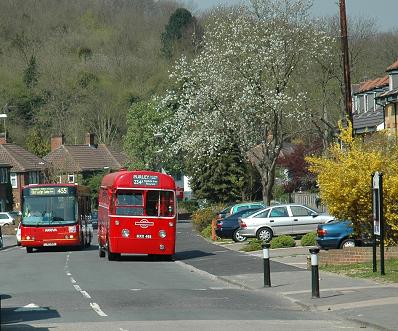 RFs were replaced by BLs on 234A in
January 1977, but the BL being used for type-training was also used
each evening (provided the driver was trained of course) for the
second half of the last duty. The driver using the normal Ultimate
ticket machine for his first spell of duty and a spare Almex for
his second spell. Doing this meant two waybills at the end of the
day but had the plus of not having to catch a service bus to Purley
as you took the BL, with the other driver bringing the RF back as
he was finished anyway. So you see, partial conversion could be
said to have happened before the last day!' RFs were replaced by BLs on 234A in
January 1977, but the BL being used for type-training was also used
each evening (provided the driver was trained of course) for the
second half of the last duty. The driver using the normal Ultimate
ticket machine for his first spell of duty and a spare Almex for
his second spell. Doing this meant two waybills at the end of the
day but had the plus of not having to catch a service bus to Purley
as you took the BL, with the other driver bringing the RF back as
he was finished anyway. So you see, partial conversion could be
said to have happened before the last day!'
Peter Taylor (like so many
others) used RFs to get to school. He remembers: 'I used the
234 (and more usually the 234A) to travel to school from
Wallington to Purley, between 1966 and 1971. I have a lasting
memory of us prim grammar school boys in our bright blue blazers
and caps waiting politely to board the RF in Belmont Road while the
scumbags from the secondary modern helped themselves to a free ride
by clambering in through the emergency exit! The poor old
drivers never seemed to understand how the bus filled up so
quick!' [Ed note: as a 'senior road', maybe some of the
drivers weren't as alert as they might have been while
concentrating on the new task of collecting fares. Where was
the Inspector? See the attached
photo of an RF in Uxbridge in the 1970s, provided by Mike Nash
- perhaps they had the same problem? (no health & safety
here...)]
Re-creation
RF406 is passed in Old Lodge
Lane by the modern equivalent of the
234A. The 12A was replaced by the
412, then by route 455 which runs from Wallington via Croydon
and is operated by Arriva from Beddington Lane with Wright-bodied
Cadets. This is DWL60.
Photo
© Steve Whitelegg
|
|